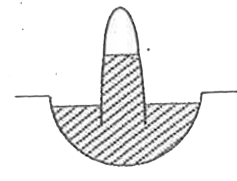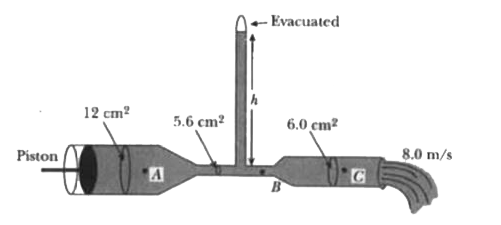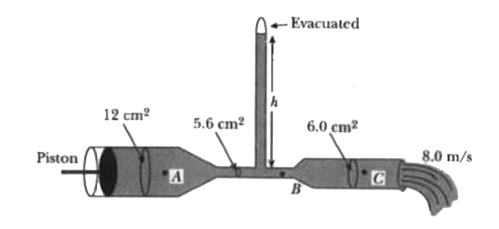A glass tube of length l0 and of uniform cross-section is to be filled with mercury so that the length of the tube unoccoupied by mercury remains same at all temperatures. If γg=3α , calculate length of mercury column.
Let x0 : length of mercury column at 0∘C
xθ : length of mercury column at θ∘C
A0 : area of cross-section of glass tube at 0∘C
Aθ : area of cross-section of glass tube at θ∘C
Aθ=A0(1+βgθ)=A0(1+2αgθ) (i)
Volume of Hg at θ∘C , (Vm_(θ)=Aθxθ
Volume of glass at θ∘C , (Vg)θ=Aθlθ
Length of glass tube unoccupied by mercury
Δl=lθ−xθ=(Vg)θAθ−(Vm)θAθ
=(Vg)0(1+3αgθ)−(Vm)0(1+γmθ)A0(1+2αgθ)
=l0(1+3αgθ)(1+2αgθ)−1−x0(1+γmθ)
(1+2αgθ)−1
=l0[1+(3αg−2αgθ]−x0[(1+(γm−2αg)θ)]
[neglecting smaller terms]
As Δl is independent of temperature
d(Δl)dthη=l0(αg)−xo(γm−2αg)=0
x0=l0αgγm−2αg=l0αγm−2α
Topper's Solved these Questions
- BOOK - CP SINGHCHAPTER - TEMPERATURE AND THERMAL EXPANSIONEXERCISE - EXERCISES64videos
TEMPERATURE AND THERMAL EXPANSION
- BOOK - CP SINGHCHAPTER - SOUND WAVESEXERCISE - Exercises130videos
SOUND WAVES
- BOOK - CP SINGHCHAPTER - UNITS, DIMENIONS AND MEASUREMENTSEXERCISE - Exercises63videos
UNITS, DIMENIONS AND MEASUREMENTS
Similar Questions
a glass tube of length 133cm and of uniform cross-section is to be filled with mercury so that the volume of the unoccupied by mercury remains the same at all temperatures. If cubical coefficient for glass and mercury are respectively 0.000026/∘C and 0.000182/∘C , calculate the length of mercury column.
View SolutionA thread of mercury of 10.2 g is in a tube of uniform cross-section 0.1cm2. Calculate the length of the thread. The density of mercury is 13.6gcm3.
View Solution
Knowledge Check
- Question 1 - Select One
The fraction of the volume of a glass flask must be filled with mercury so that the volume of the empty space may be the same at all temperature is
(αglass=9×10−6/0C,γHg=18.9×10−5/0C)A12B17C14D15 - Question 2 - Select One
Torricelli was the first do devise an experiment for measuring atmospheric pressure . He took calibrated hard glass tube , 1 m in lengt and of uniform cross section , closed at one end . He filled the whole tube with dry mercury taking care than no air or water droplets remain inside the tube , closed the opposite end of the tube tightly with thumb and inverted it . He put this inverted mercury tube into a mercury through , taking care that the end of the tube remains inside the mercury through , An interesting thing was noticed . Mercury in the tube fell down at first and then stopped at a particular position . The height was 76 cm above the free surface of mercury in the through . When the given tube was inclined or lowered in the mercury trough , the vertical haight of mercury level in the tube was always found constant .
Torricelli explained this by saying that the free surface of mercury in the trough . Hence , the hydrostatic pressure exerted by the trough measures the atmospheric pressure .

If this expriment uses water instead of mercury , thenAlength of water will be equal to 76 cmBlength of water will be less than 76 cmClength of water will be greater than 76 cmDnone of the above - Question 3 - Select One
Torricelli was the first do devise an experiment for measuring atmospheric pressure . He took calibrated hard glass tube , 1 m in lengt and of uniform cross section , closed at one end . He filled the whole tube with dry mercury taking care than no air or water droplets remain inside the tube , closed the opposite end of the tube tightly with thumb and inverted it . He put this inverted mercury tube into a mercury through , taking care that the end of the tube remains inside the mercury through , An interesting thing was noticed . Mercury in the tube fell down at first and then stopped at a particular position . The height was 76 cm above the free surface of mercury in the through . When the given tube was inclined or lowered in the mercury trough , the vertical haight of mercury level in the tube was always found constant .
Torricelli explained this by saying that the free surface of mercury in the trough . Hence , the hydrostatic pressure exerted by the trough measures the atmospheric pressure .
If an additional hole is also made at P ' at the top point of the tube , then
 Amercury will not come out of the tubeBmercury may come out of the tube after some time .Cmercury will come out of the tube instantlyDnone of these
Amercury will not come out of the tubeBmercury may come out of the tube after some time .Cmercury will come out of the tube instantlyDnone of these
A column of mercury is in the middle of horizontal tube of uniform cross section closed at both ends. The pressure of the enclosed air column on either side of the mercury is 75 cm of mercury column. When the tuve is placed vertical the length air below the mercury column is 35 th of that above it. if length of mercury column is 10n cm. find n.
View SolutionA container having base area A0. Contains mercury upto a height l0. At its bottom a thin tube of length 4l0 and cross-section area A(A<<A0) having lower end closed is attached . Initially the length of mercury in tube is 3l0. in reamining part 2 mole of a gas at temperature T is closed as shown in figure . Determine the work done (in joule) by gas if all mercury is displaced from tube by heating slowly the gas in the rear end of the tube by means of a heater. (Given : density of mercury = ρ, atmospheric pressure P0=2l0ρg,Cv of gas = 3/2R,A=(3/ρ)m2,l0=(1/9)m , all units is S.I.)
_S01_127_Q01.png) View Solution
View SolutionThe coefficient of linear expansion of glass is αg per .∘C and the cubical expansion of mercury is λm per .∘C. The volume of the bulb of a mercury thermometer at 0∘C is V0 and cross section of the capillary is A0. What is the length of mercury column in capillary at T∘C, if the mercury just fills the bulb at 0∘C ?
View SolutionA glass tube has several different cross-sectional areas with the values indicated in the figure . A piston at the left end of the tube exerts pressure so that mercury within the tube flows from the right end with a speed of 8.0 m/s . Three points with in the tube are labeled A , B and C . (Atmospheric pressure is 1.01×105N/m2 , Density of mercury is 13600kg/m3) .

At what speed is mercury flowing past the point labeled A ?View SolutionA glass tube has several different cross-sectional areas with the values indicated in the figure . A piston at the left end of the tube exerts pressure so that mercury within the tube flows from the right end with a speed of 8.0 m/s . Three points with in the tube are labeled A , B and C . (Atmospheric pressure is 1.01×105N/m2 , Density of mercury is 13600kg/m3) .

At what speed is mercury flowing past the point labeled B ?View Solution

